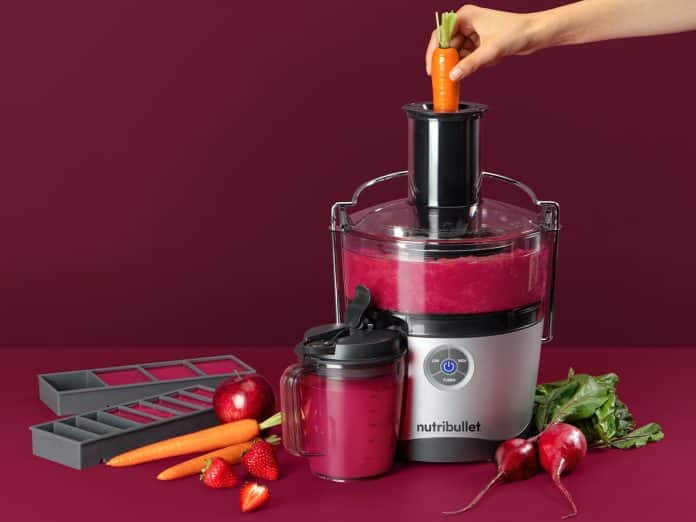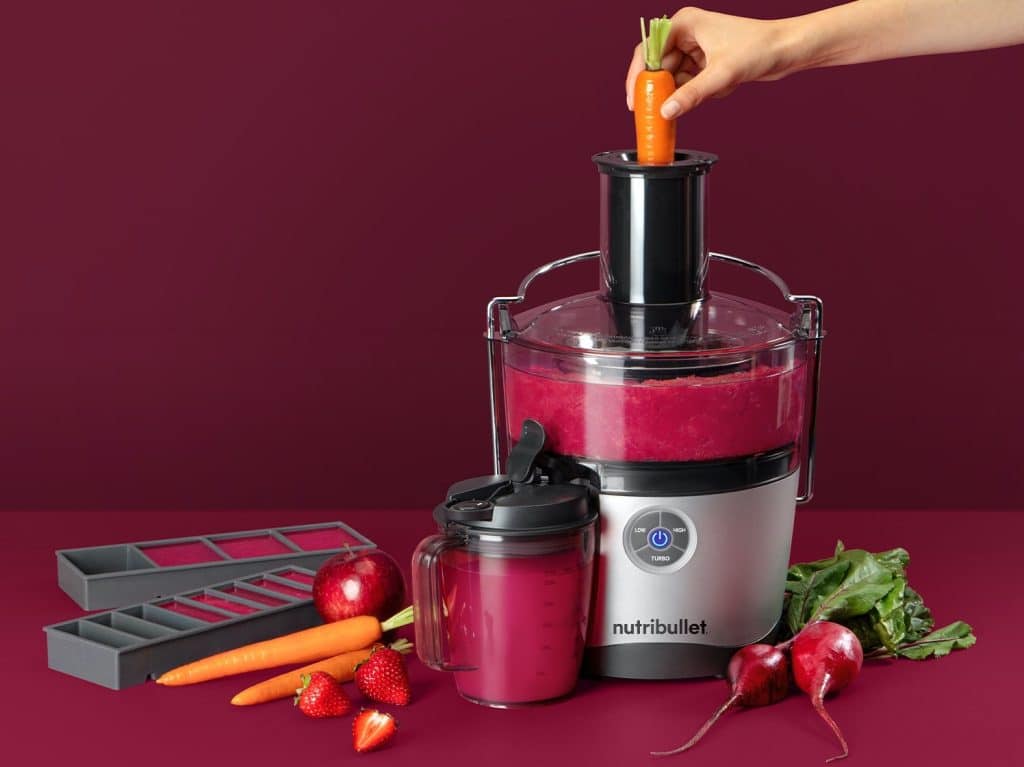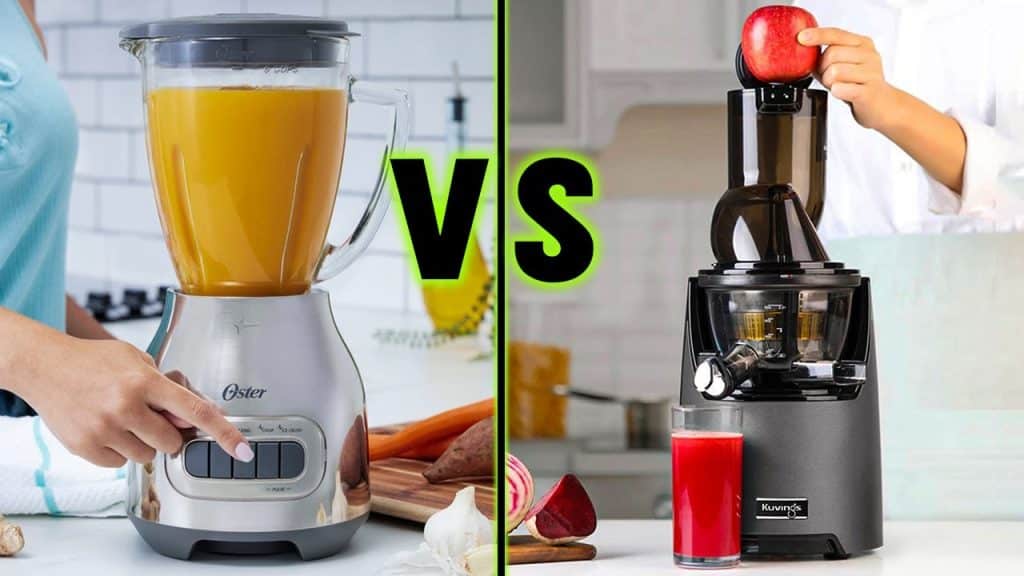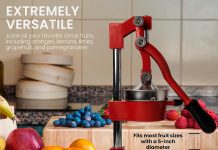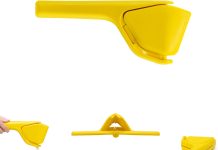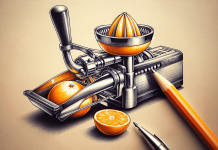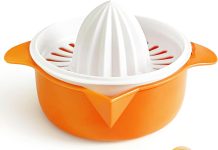We all love a healthy beverage to kickstart our day, but have you ever wondered what the difference is between a juicer and a blender?
While both appliances can whip up delicious drinks, they function quite differently. A juicer extracts the liquid from fruits and vegetables, leaving behind the pulp, while a blender blends everything into a smooth concoction.
In this article, we will explore the distinctions between these two kitchen essentials and discover which one is best suited for your personal needs. So, grab your favorite drink and delve into the world of juicers and blenders!
Review contents
What is a Juicer?
Definition
A juicer is a kitchen appliance that extracts juice from fruits and vegetables.
It separates the liquid juice from the solid pulp, resulting in a smooth, nutrient-rich drink. Juicers come in various types, each with its unique features and functionality.
Types of Juicers
There are two primary types of juicers: centrifugal juicers and masticating juicers.
Centrifugal juicers use a fast-spinning metal blade to chop the fruits and vegetables into tiny pieces. The centrifugal force then separates the juice from the pulp, which is collected in separate containers. These juicers are generally more affordable and operate at higher speeds, making them suitable for juicing softer fruits and vegetables.
On the other hand, masticating juicers use a slower rotating auger to crush and squeeze the produce, extracting the juice more efficiently. They work at lower speeds, resulting in less oxidation and heat, which helps retain more nutrients in the juice.
Masticating juicers are often more expensive but more versatile and ideal for juicing leafy greens, wheatgrass, and more complex fruits and vegetables.
How Does a Juicer Work?
Juicers employ different mechanisms to extract the juice. In centrifugal juicers, fruits and vegetables are fed through a feeding chute and pushed onto a spinning blade. The high-speed rotation generates centrifugal force, which separates the juice from the pulp. The juice is collected in a container, while the pulp is ejected into a separate compartment.
Masticating juicers work by slowly crushing the produce with a rotating drill or gears. The pulp is gradually squeezed, releasing the juice, filtered through a fine mesh screen. The pulp is pushed out through a separate outlet, and the juice is collected.
Advantages of Using a Juicer
Using a juicer offers several advantages. Firstly, it allows for quick and easy consumption of many fruits and vegetables in a convenient liquid form. This is especially beneficial for those who struggle to incorporate sufficient amounts of produce into their diet.
Juicers also maximize the extraction of nutrients, as the juicing process breaks down the cell walls of fruits and vegetables, making it easier for the body to absorb vitamins, minerals, and enzymes. Furthermore, juicing allows for customization, enabling individuals to create their own unique blends and combinations tailored to their preferences and nutritional requirements.
Disadvantages of Using a Juicer
While juicing has its benefits, there are also a few drawbacks to consider. One major disadvantage is the loss of dietary fiber during the juicing process.
Fiber plays a crucial role in digestion and aids in maintaining healthy blood sugar levels. Since juicers separate the pulp, which contains fiber, from the juice, it is essential to find alternative sources of dietary fiber in one’s diet.
Another drawback is the higher cost associated with some types of juicers, particularly masticating juicers. These juicers are more expensive due to their advanced technology and slower extraction process.
Additionally, some juicers may produce significant pulp waste, requiring regular disposal and cleaning.
What is a Blender?
Definition
A blender, a liquidizer in some regions, is a versatile kitchen appliance used for blending, pureing, and liquefying various ingredients. Unlike a juicer, a blender processes the entire fruit or vegetable, including the pulp, skin, and fiber, resulting in a thick, smooth consistency.
Types of Blenders
There are several types of blenders available in the market, each with its unique features. The most common types include countertop blenders, immersion blenders, and personal blenders.
Countertop blenders are traditional, consisting of a jar with a powered base and a blending blade. These blenders offer various speed settings and can handle a wide array of ingredients. Immersion blenders, also known as hand blenders or stick blenders, are handheld devices with a blending blade at the end. They are maneuverable and ideal for blending soups, sauces, and smoothies directly into the cooking pot.
Personal blenders are compact and portable versions of countertop blenders. They usually come with single-serve blending cups or bottles, making them convenient for on-the-go use. Personal blenders are perfect for making smoothies, protein shakes, and small batches of blended beverages.
How Does a Blender Work?
Blenders use potent motors and sharp blades to blend or puree ingredients. The ingredients are placed into the blending jar or cup, and the blades are activated to create a vortex, pulling the ingredients towards the blades. The high-speed rotation of the blades breaks down the ingredients, resulting in a smooth mixture.
Some blenders offer various speed settings, allowing users to control the blending intensity. Additionally, certain blenders may have preset programs and modes for specific functions like ice crushing or smoothie making.
Advantages of Using a Blender
Blenders offer numerous advantages in the kitchen. One of the key benefits is their versatility. Blenders can handle a wide range of ingredients, from fruits and vegetables to ice, nuts, and even grains. This versatility allows for the creation of various recipes, including smoothies, soups, sauces, dips, and batters.
Blenders also retain all the dietary fiber present in the ingredients since the whole fruit or vegetable is blended together. This fiber is essential for promoting healthy digestion, regulating blood sugar levels, and maintaining overall gut health. Additionally, blenders provide a more filling and satisfying texture due to the inclusion of pulp and fiber, making blended drinks and smoothies an excellent choice for those looking to manage their appetite.
Disadvantages of Using a Blender
While blenders offer many advantages, there are a few disadvantages to be aware of. One common drawback is the potential loss of nutrients due to oxidation and heat generated during blending. The high-speed blending process may introduce air and heat, reducing specific heat-sensitive vitamins and enzymes. However, this nutrient loss can be mitigated using shorter blending times and adding ice or frozen ingredients to keep the mixture cool.
Another limitation is the texture of the final product. Blenders are designed to create a homogenous blend, resulting in a thick and smooth consistency. While this may be preferable for some recipes, it may not suit everyone’s taste or desired texture.
Additionally, blending certain ingredients may require more liquid to achieve a smooth consistency, potentially diluting the flavor.
Differences in Purpose
Juicer’s Purpose
The main purpose of a juicer is to extract liquid juice from fruits and vegetables while separating the solid pulp. Juicers excel at creating nutrient-dense juices that are easy to consume and provide quick hydration. They are handy for those aiming to increase their intake of vitamins, minerals, and antioxidants through juice consumption.
Blender’s Purpose
In contrast, the purpose of a blender is to blend and mix various ingredients to create a smooth texture. Blenders are versatile appliances that create many recipes beyond just juice.
They are suitable for making smoothies, soups, sauces, and even grinding nuts or crushing ice. Blenders retain the entire fruit or vegetable, including the fiber and pulp, resulting in a thicker, more filling consistency.
Differences in Functionality
Juicer’s Functionality
Juicers are specifically designed to extract liquid from fruits and vegetables while separating the pulp. Depending on the type, they operate at high speeds or slow rotations and employ different mechanisms such as spinning blades or augers to achieve the desired extraction. Juicers excel at extracting juice quickly and efficiently, providing a smooth and refreshing drink.
Blender’s Functionality
On the other hand, blenders focus on blending and mixing ingredients to create a uniform texture. They use powerful motors and sharp blades to pulverize and combine the ingredients, resulting in a creamy and consistent blend.
Blenders can handle a more comprehensive range of ingredients, including ice, frozen fruit, and various liquids, making them versatile appliances for different recipes.
Differences in Extraction
Juicer’s Extraction Process
Juicers extract juice by separating the liquid content from the solid pulp. The process involves breaking down the cell walls of fruits and vegetables and extracting the juice either through centrifugal force or by slow crushing and squeezing.
This separation of juice from pulp allows for a clear, smooth, and pulp-free juice.
Blender’s Extraction Process
In contrast, blenders do not separate the juice from the pulp; they blend the entire fruit or vegetable together. The blending process breaks down the fibers and cells, resulting in a homogenous mixture that retains both the juice and the pulp.
Blenders create a thicker and more viscous texture, incorporating all the components of the ingredients into the final blend.
Differences in Texture
Juicer’s Effect on Texture
Juicers produce a texture that is smooth and free of pulp or fiber. The extraction removes all solid particles, producing a clear and light juice. This texture is ideal for those who prefer a refreshing and less filling drink.
Blender’s Effect on Texture
On the other hand, blenders create a thicker and more dense texture due to the inclusion of pulp and fiber. Blended recipes are smooth and creamy, making them more satisfying and filling. The texture of blended drinks can be adjusted by varying the blending time and amount of liquid added, allowing for customization according to personal preferences.
Differences in Nutrient Retention
Juicer’s Impact on Nutrient Retention
Juicers have the advantage of maximizing nutrient retention during the extraction process. While some heat and oxidation may occur in centrifugal juicers due to the high-speed spinning, the slower extraction process of masticating juicers minimizes nutrient loss. By breaking down the fruits and vegetables, juicers make the nutrients more readily available for absorption.
Blender’s Impact on Nutrient Retention
Blenders may introduce more heat and oxidation due to the high-speed blending process, potentially leading to some nutrient loss, particularly heat-sensitive vitamins and enzymes. However, including the entire fruit or vegetable in the blend helps retain fiber and other nutrients that may be lost in the juicing process. Adding ice or frozen ingredients to the blend can also help maintain a cooler temperature and reduce nutrient degradation.
Differences in Ingredients
Juicer’s Compatibility with Ingredients
Juicers are generally well-suited for juicing a wide variety of fruits and vegetables, including harder produce like apples and carrots.
They can efficiently extract juice from leafy greens, such as spinach and kale, packed with vitamins and minerals. Some juicers may struggle with very fibrous ingredients, like pineapple cores or ginger, requiring additional preparation or adjustment.
Blender’s Compatibility with Ingredients
Blenders have a broader compatibility with ingredients. They can handle various fruits, vegetables, ice, liquids, and even stricter ingredients like nuts and seeds.
Blenders are suitable for creating smoothies, soups, sauces, and dips, allowing for greater versatility in the kitchen. Their blending capabilities can help unlock the flavors and textures of ingredients in different culinary creations.
Differences in Cleanliness
Ease of Cleaning a Juicer
Juicers typically require more cleaning effort due to separating juice and pulp. The different components, such as blades, screens, and containers, must be disassembled and washed thoroughly after each use. Some juicers may have more intricate parts that need special attention for complete cleaning, making it a slightly more time-consuming task.
Ease of Cleaning a Blender
Blenders, especially those with removable blades, are generally easier and quicker to clean. After blending, adding water and a small amount of dish soap to the blending jar and blending for a few seconds can remove most residue. Immersion blenders are incredibly convenient, as their detachable blending head can be quickly rinsed or placed in the dishwasher. However, the seals and grooves of blenders may require extra attention to avoid buildup or odors.
Conclusion
In conclusion, juicers and blenders have unique purposes, functionalities, and advantages. Juicers are specifically designed to extract liquid juice from fruits and vegetables, providing a convenient and nutrient-dense drink. They separate the pulp, resulting in a smooth and pulp-free texture.
On the other hand, blenders blend the entire fruit or vegetable, including the pulp and fiber, creating a thick and more filling texture. Blenders offer versatility in creating a wide range of recipes beyond just juice.
When deciding between a juicer and a blender, consider your preferences, dietary goals, and the types of recipes you plan to make. Juicers are ideal for individuals seeking a quick and refreshing juice experience, while blenders offer more flexibility and the ability to retain all the nutrients and fiber of the ingredients.
Ultimately, both appliances can play a valuable role in a healthy and balanced diet, providing convenient ways to incorporate more fruits and vegetables into daily life.

